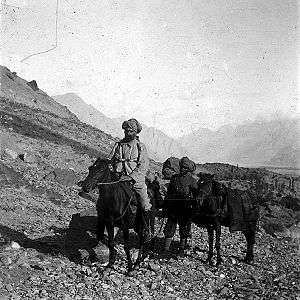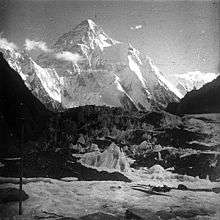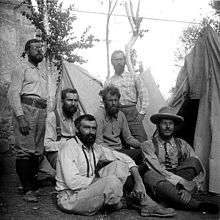Jules Jacot-Guillarmod
Jules Jacot-Guillarmod was a Swiss physician, mountaineer and photographer. He was born in La Chaux-de-Fonds in 1868 and died in the Gulf of Aden in 1925. As a mountaineer he was known for his ascensions in the Swiss Alps but particularly for his participation in two Himalaya expeditions.

Biography
Jules Jacot-Guillarmod was the son of the animal painter Jules Jacot-Guillarmod (1828-1889). He successfully studied medicine in Lausanne and Zurich between 1888 and 1895. Graduated in 1895, he established himself as a general practitioner at Corsier (Canton of Geneva), from 1898 to 1902 at Lignières from 1904 to 1910 and then at Saint-Blaise (canton of Neuchâtel) from 1910 to 1912. In 1907, he married Madeleine Bovet. From 1912 on, he ran a psychiatric clinic located at the Château de Prilly and in 1920, the couple bought the château after running the clinic in Vennes between 1915 and 1920.[1] · [2]. He frequently travelled the Alps with his comrades from the Swiss Alpine Club while giving numerous lectures commenting on his expeditions and regularly publishing articles for Swiss newspapers and magazines. Jules Jacot-Guillarmod was also very active in various groups: he was appointed president of the Diablerets section of the Swiss Alpine Club from 1915 to 1917 and also president of the Swiss Association of Geographical Societies from 1917 to 1920. Various honorary awards crown his exploits: in 1920, he was appointed Officer of the Order of Saint Charles by Albert I of Monaco at the Monaco Mountaineering Congress and in 1925, King Fouad I of Egypt made him Grand Officer of the Order of the Nile at the International Geographical Congress in Cairo[3] · [2].
First ascents
Jules Jacot-Guillarmod climbed his first summit of 2,169 metres in 1889 during an excursion with friends in the Fribourg region. At the beginning of 1890, he bought an ice axe and hiked around Mont Blanc for the first time. In 1893, Jules Jacot-Guillarmod climbed the Jungfrau, his first peak of 4,000 metres, accompanied by a professor and a group of students. On June 12, 1897, after cycling from Martigny to Chamonix with two friends, he climbed the Mont Blanc for the first time, without a mountain guide. A few months later, on a training course in Paris, he gave a lecture on it at the Club Alpin Français (CAF) and is soon after accepted as a member. His contacts within the CAF lead to his first expedition project in the Himalayas, however abandoned for lack of funding[4] · [2].
Himalaya expeditions


In 1902, Jules Jacot-Guillarmod participated as a doctor in the expedition organised by the Englishman Oscar Eckenstein to try the ascent of the K2 in the Karakoram. The other members are two Englishmen including Aleister Crowley and two Austrians. After landing in Bombay on 21 March 1902, the group crossed India to Askoley, following the maps drawn ten years earlier by William Martin Conway up to Concordia Square on the Baltoro glacier; they were accompanied by a column of 150 porters. From there, the group climbs up to the foot of the K2, an area never reached before, but remains stuck for almost two months on a base camp at an altitude of 5,700 metres due to bad weather. Jules Jacot-Guillarmod makes the first observations of mountain sickness there: migraines, loss of appetite, nausea, etc., however he did not make the link between altitude and these symptoms. On July 10, 1902, he explored the Northeast ridge of the K2 with one of the Austrians and reaches an altitude of 6,700 metres, the highest point of the expedition. The weather conditions deteriorated the following days and one of the climbers suffered from a pulmonary edema. The travellers return across eastern India, making the stay to last a total of seven months. Jules Jacot-Guillarmod brings home from this expedition nearly a thousand stereoscopic photographs revealing regions little or not at all known at the time[5] · [6]. Two years later, Jacot-Guillarmod himself organized an expedition, this time to the Napalese and 8585m high Kangchenjunga near Everest. Apart from two Swiss, he also manages to win Aleister Crowley, whom he has met during the K2 expedition in 1902. For the organisation of the expedition in Darjeeling they call upon an Italian hotelier with local language skills. From Darjeeling, the group advances on the border between Sikkim and Nepal.[2] After climbing through the Yalung Chu valley, the summit is approached by a very steep glacier: three Nepalese carriers and a Swiss participant lose their lives falling into a crevasse at an altitude of 6,500 metres. The expedition is thus brutally stopped and the return journey through the Sikkim mountains is made without Crowley, who fled after the avalanche.[2]
Other expeditions
In 1919, Dr Georges Montandon, an ethnologist from Neuchâtel, is commissioned by the ICRC to visit the Austro-Hungarian prison camps in Siberia. Jules Jacot-Guillarmod is part of the nine-month mission which must pass through the United States and Japan to inspect the camps in Russia. He returns to Switzerland in December 1919 after travelling some 40,000 kilometres[7]. In 1925 Jacot-Guillarmod attends the International Geographical Congress in Cairo. After the congress he intends to cross Africa to the Cape. But on arriving at Lake Victoria, he falls so seriously ill that he decides to return home via Mombasa. However, he dies of mycarditis at sea and is buried in the Maala cemetery in Aden/Yemen.[2]
Publications
- Journal du 1er janvier 1886 au 27 mai 1925, 74 carnets; Fonds Jacot-Guillarmod, Bibliothèque de la ville de La Chaux-de-Fonds.
- Nouvel an à la cabane Fridolin, L'Écho des Alpes, 1895, p. 117-131
- Au Mont-Blanc, L'Écho des Alpes, 1897, p. 249-268
- Autour de Chanrion, Patrie suisse, n°4, 1897, p. 279-281
- La pellotine chez les aliénés, Thèse de doctorat de Jules Jacot-Guillarmod, Lausanne, 1897
- Album des cabanes du Club Alpin Suisse, Berne, Schmidt & Francke, 1898
- Dans les Alpes de la Suisse primitive, L'Écho des Alpes, 1896, p. 211-217 et 335-345
- Dans l'Himalaya, Suisse libérale, 1902, numéros 107 (9 mai), 108 (10 mai), 121 (26 mai), 122 (27 mai), 158 (8 juillet), 159 (9 juillet), 166 (17 juillet), 167 (18 juillet), 184 (7 août), 209 (5 septembre), 210 (6 septembre), 219 (17 septembre), 220 (18 septembre)
- Un record dans l'Himalaya, Jahrbuch des Schweizer Alpen Club, n°38, 1902-1903, p. 212-227
- Six mois dans l'Himalaya, le Karakorum et l'Hindu-Kush: voyages et explorations aux plus hautes montagnes du monde, Neuchâtel, W. Sandoz, 1904
- Vers le Kangchinjunga (8585m), Himalaya népalais, Jahrbuch des Schweizer Alpen Club, n°41, 1905-1906, p. 190-205
- Au Mönch (4105m) par l'arrête nord-ouest, Jahrbuch des Schweizer Alpen Club, n°43, 1907-1908, p. 364-371
- Crampons et piolets, Jahrbuch des Schweizer Alpen Club, n°45, 1909-1910, p. 344-353
- Au Kangchinjunga: voyages et explorations dans l'Himalaya du Sikhim et du Népal, L'Écho des Alpes, 1914, p. 389-406
- À l'assaut des plus hauts sommets du monde, L'Écho des Alpes, 1921, p. 337-350
- Les grottes des Dentaux, Bulletin de la Société vaudoise des sciences naturelles, n°203, 1921, p. 193-204
- Les résultats de l'expédition de l'Everest en 1921, L'Écho des Alpes, 1922, p. 117-120
- Esquisses topographiques du Chogori ou K2 et du Kangchinjunga (Himalaya), Bulletin de la Société neuchâteloise de Géographie, vol. XXXIV, Neuchâtel, 1925, p. 34-37.
Citations
-

- (Kurz 1948, p. 191-198)
-

-

- (Buffet 2012, p. 25-103)
- (Baud 2003, p. 83-85)
- (Buffet 2012, p. 14-23)
References
- Aymon Baud, La haute Asie telle qu'ils l'ont vue. Explorateurs et scientifiques de 1820 à 1940, 2003
- Charlie Buffet, La folie du K2, 2004
- Charlie Buffet, Jules Jacot-Guillarmod Pionnier am K2. Entdecker und Fotograph im Himalaya, 1902-1905, 2012
- Marcel Kurz, Fremde Berge, ferne Ziele. Das Werk schweizerischer Forscher und Bergsteiger im Ausland, 1948
- Louis Seylaz, Jules Jacot Guillarmod, in: Les alpinistes célèbres, Henri de Segogne und Jean Couzy, 1956, p. 123-135.
- Georges Terrier, Jules Jacot Guillarmod, médecin, alpiniste et grand voyageur (1868-1925), in: Biographies neuchâteloises tome 4 (1900-1950), Michel Schlup, 2005, p. 149-153.
- Steve Swenson, Mountain Profile: K2, the Mountaineers' Mountain, Alpinist, 37, 2011-2012, p. 42-46.